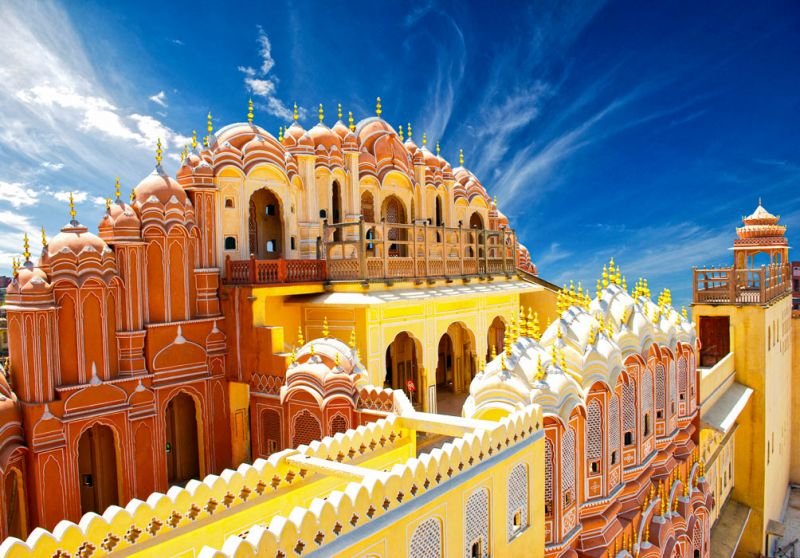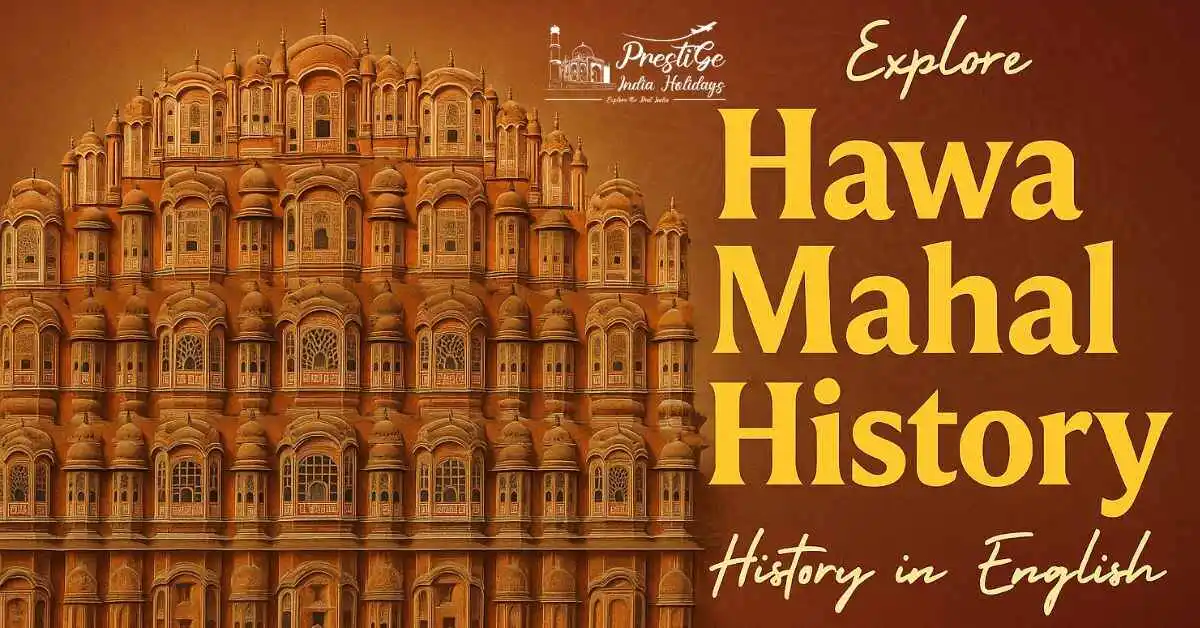Welcome to Prestige India Holidays, your trusted guide to the royal wonders of India! Today, let’s take a deep dive into the enchanting Hawa Mahal History In English a tale woven with royal customs, architectural brilliance, and stories that blow through time like a gentle breeze. If you’re curious about the History Of Hawa Mahal, who built it, and why it stands as a symbol of Jaipur’s regal past, you’re in the right place. Let’s go on this journey together, using simple words, comforting explanations, and a touch of Indian warmth.
Introduction Why Hawa Mahal Captures Every Heart
If there’s one place in Jaipur that truly makes you feel like royalty with just one look it’s the Hawa Mahal, he “Palace of Winds”. Let’s take a royal walk through Hawa Mahal History In English, written in a way you’ll enjoy every bit. With its honeycomb structure and 953 tiny windows, it’s not just a palace, it’s an emotion. The History of Hawa Mahal is not just dates and facts—it’s a blend of dreams, culture, and clever architecture. Sitting like a golden crown in the heart of Jaipur, this architectural gem isn’t just a pretty face. The Hawa Mahal history is as fascinating as the palace itself, and today, we’re peeling back the layers to reveal everything from who built it and why, to the cultural magic it holds even now.
What Is Hawa Mahal?
Hawa Mahal, also known as the “Palace of Winds,” located in Jaipur, Rajasthan, is not just a palace it’s a living legend nestled in the heart of Jaipur, Rajasthan. It is a five-storied structure made with red and pink sandstone. It’s not a full-fledged palace in the traditional sense but a high-screen wall built so that royal women could observe street festivals while remaining unseen by the public, an architectural marvel blending beauty with purpose.
Hawa Mahal is more than just a pretty face, it’s a landmark that defines the Pink City. Built in 1799, it’s known as the “Palace of Winds”!
- Location: Badi Chaupad, Jaipur, Rajasthan.
- Material Used: Red and pink sandstone.
- Style: Blend of Rajput and Mughal architecture.
- Built in: 1799.
- Famous for: 953 tiny windows, called jharokhas, and its honeycomb design Designed by: Lal Chand Ustad.

Hawa Mahal History In English: The Story Behind the Palace
The History Of Hawa Mahal begins with Maharaja Sawai Pratap Singh, a ruler from the Kachhwaha Rajput dynasty. In 1799, after being captivated by the unique Khetri Mahal in Jhunjhunu, he decided to create a palace that would stand out from the crowd—a place where the winds could whisper royal secrets and the women of the royal family could watch the world go by without being seen.
- Hawa Mahal Built By: Maharaja Sawai Pratap Singh, inspired by Khetri Mahal.
- Architect: Lal Chand Ustad, a master of his craft.
Why Was Hawa Mahal Built?
Back in the day, the purdah (Parda) system was strictly followed. Royal women were not allowed to show their faces in public. The Hawa Mahal History tells us that the palace was designed with 953 windows so these women could enjoy the street festivities and daily life outside, all while remaining hidden from the public eye.
“The windows of the Hawa Mahal, known as the Jharokhas, were built in such a way that everything was visible from the inside but nothing from the outside.”
Highlights of Hawa Mahal History In English
Let’s break down the most fascinating facts about this palace, so you can remember them at a glance:
- Built in 1799 by Maharaja Sawai Pratap Singh.
- Inspired by Khetri Mahal in Jhunjhunu.
- Designed by Lal Chand Ustad, a renowned architect.
- 953 windows (jharokhas) allow cool breezes to flow through, keeping the palace comfortable.
- Five floors, each with unique chambers and minimal ornamentation.
- Red and pink sandstone construction, giving it a royal glow.
- Purpose: To allow royal ladies to observe street life without being seen.
- Blend of architectural styles: Rajput, Mughal, and Islamic elements.
Step Into the Past: The History Of Hawa Mahal
The History of Hawa Mahal in English is a tale of vision and tradition. Maharaja Sawai Pratap Singh, the grandson of Jaipur’s founder, Maharaja Sawai Jai Singh, wanted a palace that would not only be a sight for sore eyes but also serve a noble purpose. He called upon the skilled architect Lal Chand Ustad, who designed the palace with a pyramidal structure that almost looks like a crown atop Jaipur’s head.
A Palace With a Purpose
- Ventilation and Comfort: The 953 windows were not just for show. They allowed the famous Jaipur breeze to flow through, making the palace a cool haven even during the scorching Rajasthan summers.
- Privacy for Royal Women: The latticework on the windows created a one-way mirror—royal ladies could see out, but no one could see in.
- Cultural Connection: The palace is an extension of the City Palace and leads directly to the women’s chambers, or zenana.
Hawa Mahal Built By: Maharaja Sawai Pratap Singh:
When we talk about Hawa Mahal Built By, the credit goes to Maharaja Sawai Pratap Singh. He was a ruler who believed in blending beauty with practicality. His admiration for Khetri Mahal’s design sparked the idea for Hawa Mahal, and he spared no effort in making it a masterpiece.
Lal Chand Ustad: The Master Architect
Every grand palace needs a visionary architect. Lal Chand Ustad, with his keen eye for detail and love for intricate designs, brought the Maharaja’s dream to life. The result? A palace that looks like a honeycomb from the outside and feels like a breath of fresh air inside.

The Magic of Hawa Mahal’s Architecture
The History Of Hawa Mahal is not just about dates and kings it’s about the fusion of cultures. The palace combines Rajput grandeur with Mughal elegance and Islamic artistry.
- Domed canopies
- Floral and lotus motifs
- Fluted pillars
- Filigree stonework
- Lavish arches
Five Floors of Wonder
Each floor tells its own story:
- Ground Floor: Welcomes you with a charming fountain and a spacious courtyard.
- First & Second Floors: Feature patios and pillared chambers.
- Top Three Floors: Narrower, with rooms just one chamber wide, offering panoramic views of Jaipur.
- Museum: Houses relics and miniature paintings, giving you a peek into royal life.
The Honeycomb Effect
The palace’s 953 jharokhas create a honeycomb effect, making it look like a beehive from afar. This design is not just for beauty it’s functional, too, letting in cool breezes and keeping the interiors pleasant.
Hawa Mahal History In Hindi: A Cultural Connection
For those who prefer to learn in their mother tongue, the Hawa Mahal History In Hindi is equally fascinating. The palace is called “हवा महल,” and its story is shared across generations in Rajasthan, keeping the legacy alive. Whether you read about the History Of Hawa Mahal in English or Hindi, the essence remains the same a celebration of royal life, tradition, and architectural genius.
Why Visit Hawa Mahal? Experience the Living History
- Step Back in Time: Walk through the same corridors where royal women once watched the world go by.
- Marvel at the Architecture: Every window, arch, and cornice tells a story.
- Feel the Breeze: Experience the cooling effect that made Hawa Mahal famous.
- Capture the View: The top floors offer breathtaking vistas of Jaipur’s City Palace, Jantar Mantar, and bustling bazaars.
- Cultural Immersion: Learn about the customs, traditions, and daily life of the Rajput royals.
Comparing Hawa Mahal History In English vs. Hawa Mahal History In Hindi
While Hawa Mahal History In English reaches global tourists, Hawa Mahal History In Hindi touches the hearts of locals and national travelers. The two languages, while different, both preserve the soul of the story.
Experience Hawa Mahal With Prestige India Holidays
At Prestige India Holidays, we believe that exploring the Hawa Mahal History In English should be as easy as a walk in the park. Our expertly curated Jaipur tours include a visit to this iconic palace, where our guides share stories, legends, and hidden gems that bring the History Of Hawa Mahal to life.
- Personalized tours
- Comfortable travel arrangements
- Expert guides with local insights
- Unforgettable memories
Conclusion
The Hawa Mahal History In English is a journey through time, culture, and royal tradition. From its 953 windows to its stunning pink façade, every corner of this palace has a story to tell. So, why not let the winds of history guide your next adventure? Book your Jaipur tour with Prestige India Holidays and experience the magic of Hawa Mahal for yourself.
Don’t just read about history—step into it!
FAQ’s
Q. Who built Hawa Mahal?
Ans. Hawa Mahal was built by Maharaja Sawai Pratap Singh in 1799, inspired by Khetri Mahal and designed by Lal Chand Ustad.
Q. Why does Hawa Mahal have so many windows?
Ans. The 953 windows were designed to allow royal women to observe street life without being seen and to let cool air circulate through the palace.
Q. What is the architectural style of Hawa Mahal?
Ans. It’s a blend of Rajput, Mughal, and Islamic styles, with intricate latticework, domed canopies, and floral motifs.
Q. What is the significance of Hawa Mahal in Jaipur’s culture?
Ans. Hawa Mahal is a symbol of Jaipur’s royal heritage, reflecting the customs and traditions of the Rajput era.
You May Also Like: Top 10 Tourist Places in Kerala, 4 Nights 5 Days Golden Triangle Tour



